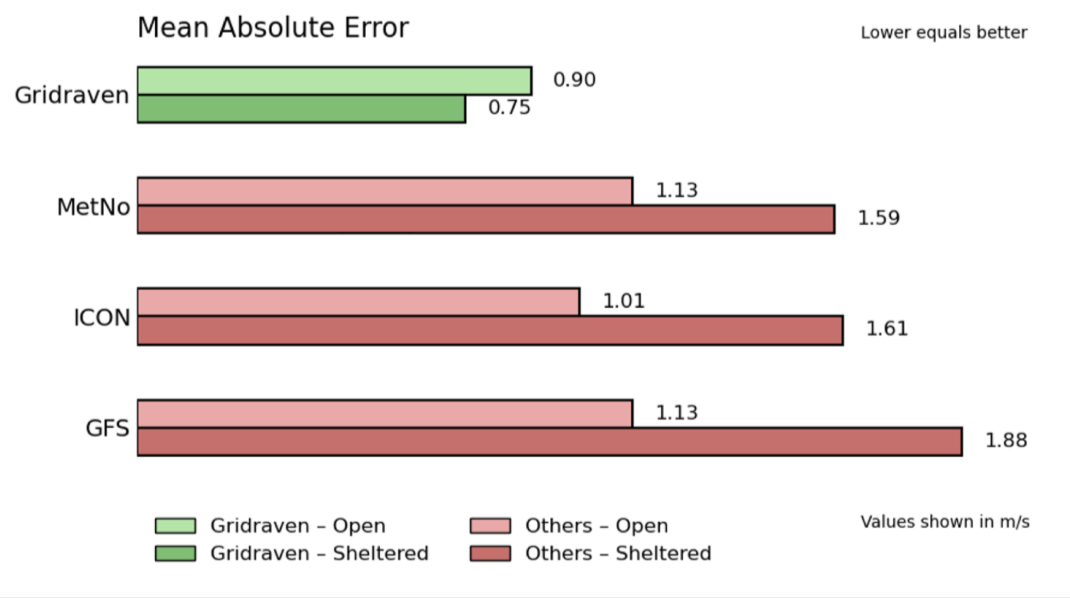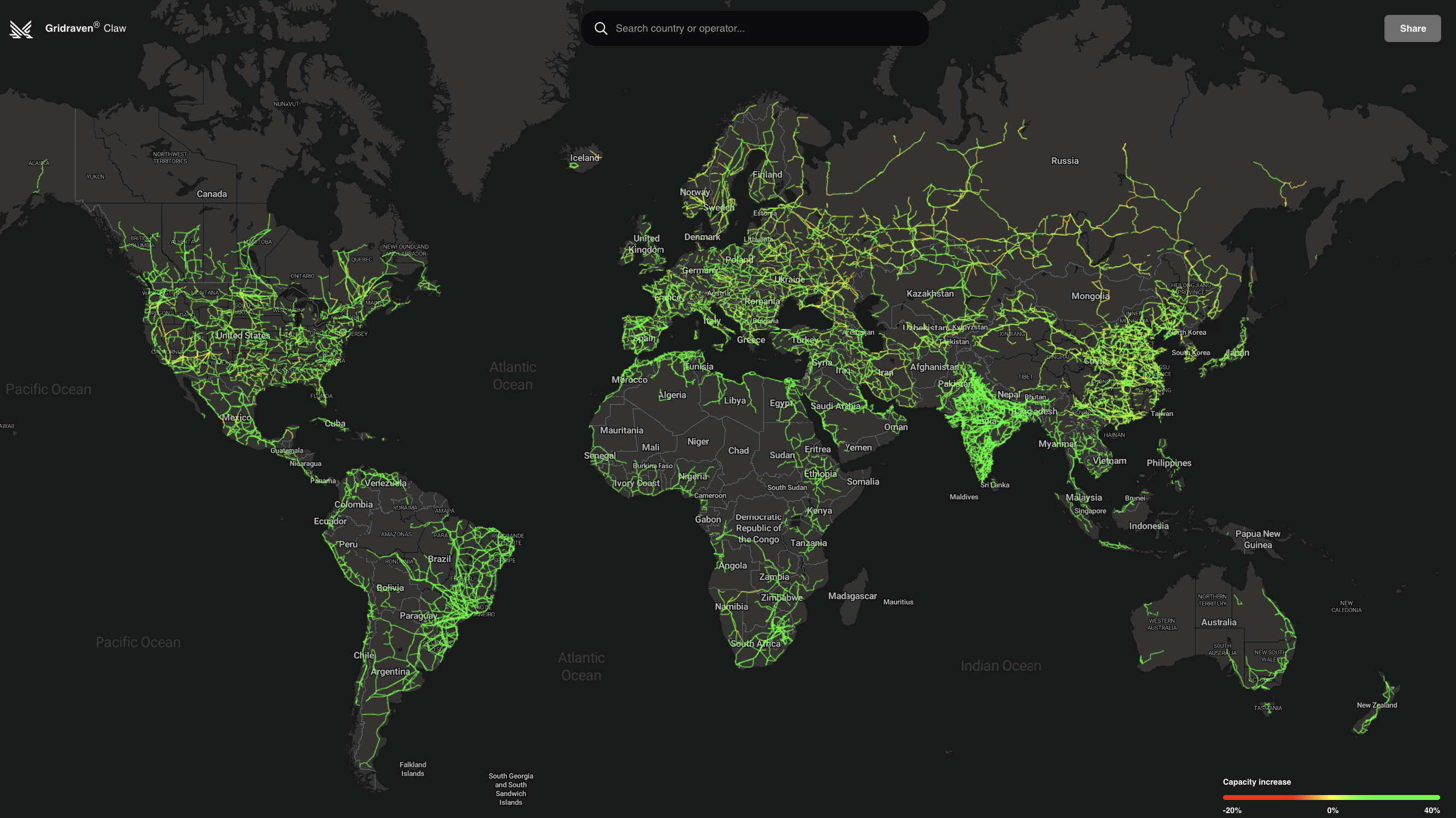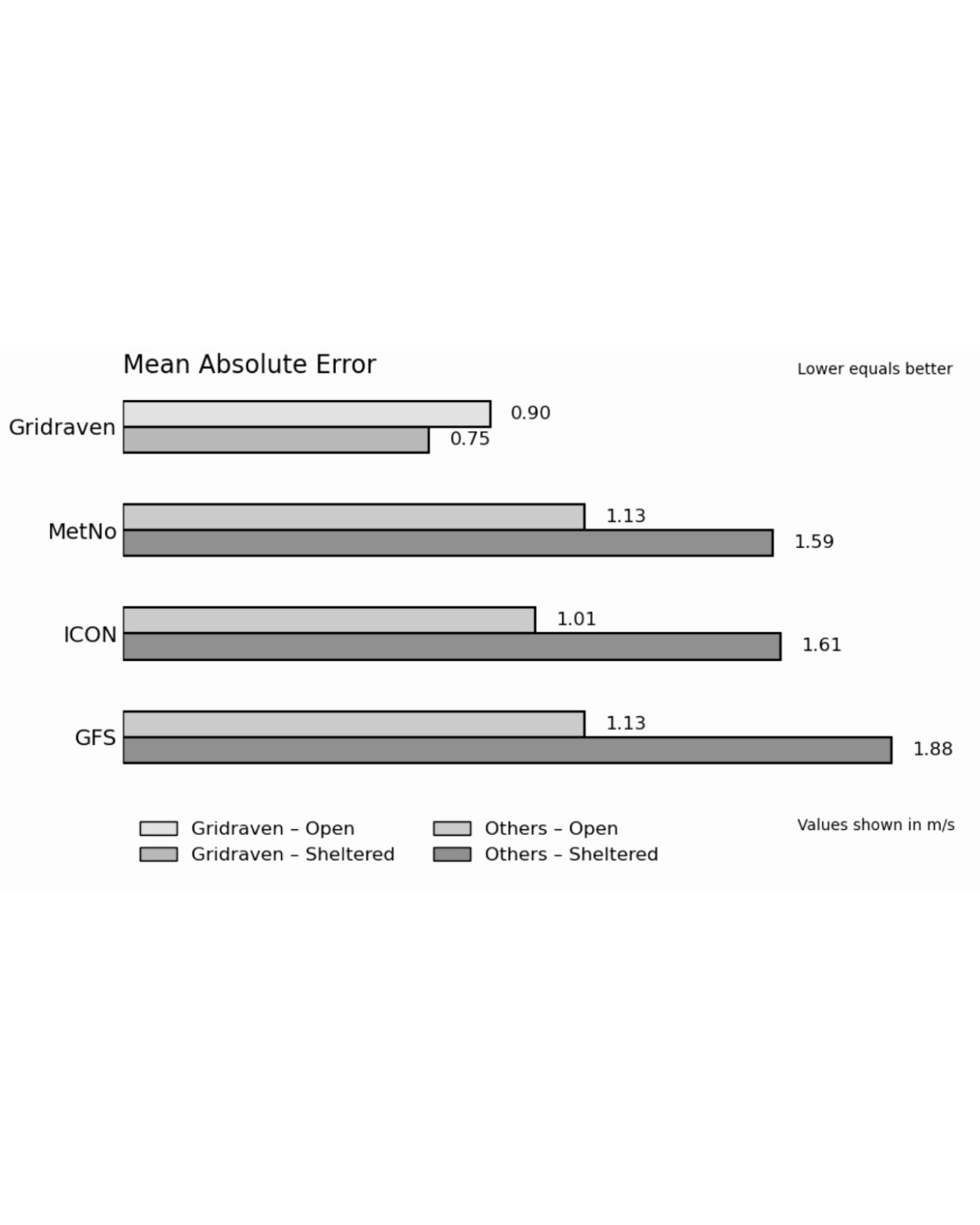Why DLR Has Not Yet Scaled
Dynamic Line Ratings adjust the capacity of power lines based on measured or forecasted wind, temperature, and solar radiation. Traditional methods, however, fall short in delivering the precision and coverage needed for widespread use. Here's a breakdown of the key challenges with legacy DLR solutions:
Digital DLR: Relying on Third-Party Weather Models
Plugging weather parameters into IEEE or CIGRE thermal rating models is straightforward. There are numerous solutions providers who offer DLR among a suite of power line modeling or optimization tools. However, this approach is far from reliable and engineers know it:
1. Inherent Inaccuracies: Wind forecasts are notoriously poor in sheltered or complex terrains, where microclimates can vary dramatically. These systems might perform adequately in open, flat areas—but most power lines cross sheltered terrain at least in some length.
2. Lack of Granularity: Generic weather models have at best 1 km resolution and don't account for span-specific conditions, leading to overly generous ratings that would lead to safety violations and damage to equipment.
The result? Utilities hesitate to trust these ratings, limiting DLR to pilot projects rather than full-scale implementation.

Weather Stations for Calibration
To address weather forecast inaccuracies, some solutions deploy weather stations on transmission towers to calibrate wind forecasts. This approach has merit but comes with significant drawbacks:
1. Limited Coverage: Stations can only monitor critical spans, not the entire network. Identifying those "critical" spots is tricky, as thermal hotspots shift with changing weather conditions.
2. Time-Intensive Setup: Gathering a reliable time series of data takes up to two years, delaying rollout and benefits.
3. Scalability Issues: Expanding to cover more lines is slow and resource-heavy, making it impractical for large grids.
While calibration improves accuracy in spots, it doesn't solve the broader problem of network-wide visibility. As a result, weather station calibrated DLR has been rolled out on a handful of the most critical lines only.
Sensor-Based Systems: Sag, Temperature, Tension, and Vibration Monitoring
Hardware sensors offer real-time measurements. But since the vast majority of the value of DLR is in day-ahead operational planning, not in real time, then the business value from hardware sensors is relatively small.
1. No True Forecasting Capability: Sensors provide real-time data but can't predict future conditions. For forecasting they still rely on inaccurate weather models and require calibration.
2. Calibration Inaccuracies: When hardware sensors are used for calibrating weather forecasts in order to obtain day-ahead forecasts, then there are multiple steps in between. For example, effective wind speed might be determined from conductor vibrations, which is inaccurate. Why not install a wind sensor directly, that has much higher accuracy?
3. Calibration Delays: Like weather stations, sensors need time to calibrate against actual performance, further slowing adoption.
4. Limited Coverage: Sensors can only monitor a handful of spans, not the entire network, but identifying these critical spans is tricky.
5. Deployment and Maintenance Challenges: Installing sensors is expensive and time-consuming, often limited to presumed critical spans. Reliability is a concern and sensors have short lifespans, requiring frequent maintenance or replacement.
6. High Costs: The upfront investment, plus ongoing upkeep, makes these systems uneconomical for broad deployment, especially since the majority of value from day-ahead operational planning can be obtained with cheaper, weather station based approaches.
Hardware sensors are effectively weather stations with extra steps, causing a loss of accuracy.
In essence, legacy DLR tools are stuck in a cycle of partial solutions: they're either inaccurate, incomplete, or too burdensome to scale.
Gridraven's Uniqueness: Accurate, Hardware-Free DLR for Every Span
At Gridraven, we've developed a breakthrough that overcomes these barriers and is already being connected to system operation across all of Finland’s transmission grid. This is to our knowledge the world’s biggest DLR adoption, and we’ve only just started.
Our sensorless DLR platform leverages advanced AI for wind and weather prediction, without hardware, calibration, or delays.
Span-Specific Precision: Using AI-driven wind forecasts based on 1-meter resolution digital elevation models, we generate hyper-local predictions for every segment of your lines. Our system directly accounts for terrain, vegetation, and other factors that legacy forecasts ignore.
From Real-Time up to Multiple Days Ahead: Gridraven’s DLR forecasts are provided from the operational hour up to ten days into the future, in time for operational planning processes and day-ahead energy markets.
Immediate Deployment: Skip the two-year calibration wait. Gridraven is ready out-of-the-box, enabling DLR integration into operational planning right away.
Global Coverage: Our platform already spans all lines worldwide. Whether you're managing a regional grid or a national network, we provide reliable insights without installing a single sensor.
Cost-Effective and Reliable: By eliminating hardware, we cut costs dramatically while avoiding maintenance headaches and reliability issues.
Ready to Scale Your Grid?
The era of limited DLR is over. Gridraven empowers utilities to unlock full capacity, reduce congestion, and support the energy transition without the pitfalls of legacy systems. Contact us today to schedule a demo and see how our AI-powered solution can transform your network.






